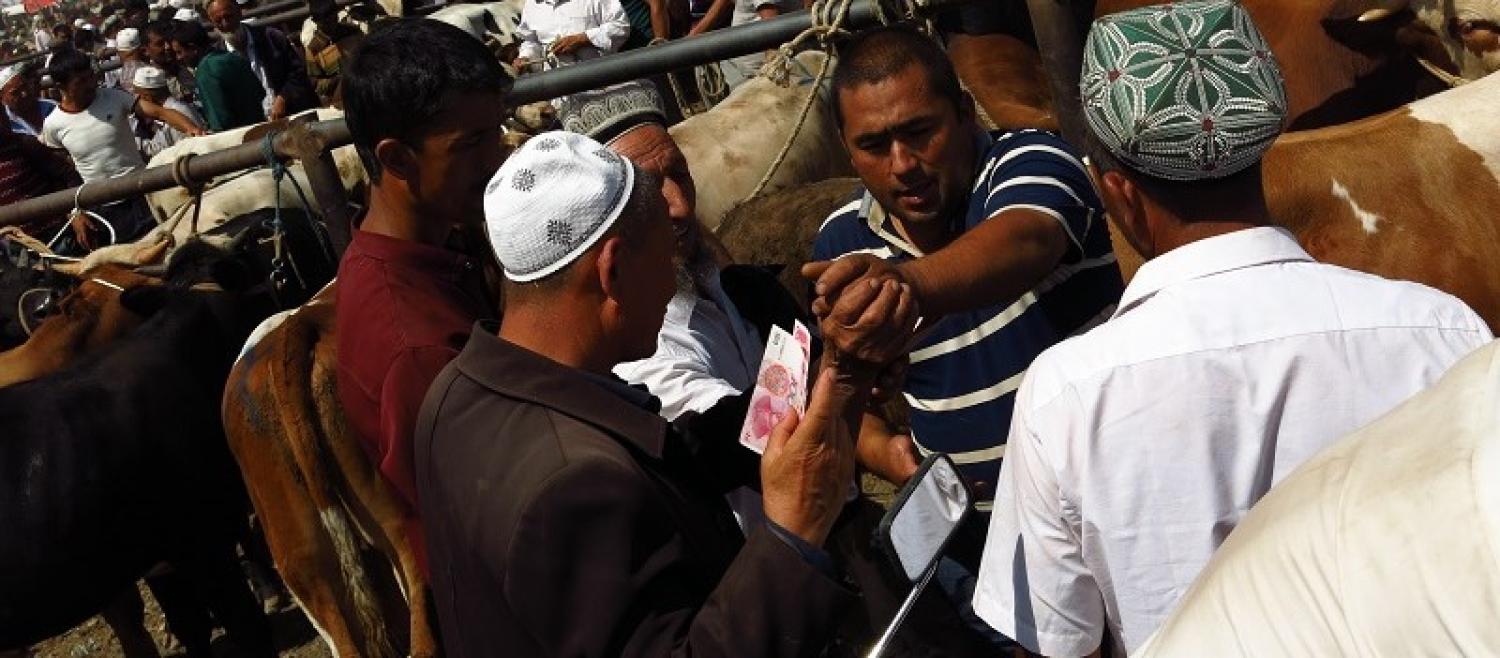The storied Karakoram Highway (KKH), a modern incarnation of the ancient silk road, is the primary ground transport link between China and Pakistan, and the highest paved road in the world. The existing Highway, completed in 1978, is undergoing a major reconstruction. Along with other transport and energy development projects, the Highway upgrade is aimed at promoting economic development for the two countries. But if those projects work they will also bind them more closely strategically, and strengthen the writ of the state in sparsely-populated restive regions of both countries.
This photo essay illustrates some of those issues. The photos were taken in early July 2016, when I and my party drove along the entire Chinese part of the Karakoram Highway, from Kashgar to the Pakistani border. Part 1 of this essay is here.
[[{"fid":"184366","view_mode":"default","fields":{"format":"default","alignment":"","field_file_image_alt_text[und][0][value]":false,"field_file_image_title_text[und][0][value]":false},"type":"media","field_deltas":{"1":{"format":"default","alignment":"","field_file_image_alt_text[und][0][value]":false,"field_file_image_title_text[und][0][value]":false}},"link_text":null,"attributes":{"height":449,"width":800,"class":"media-element file-default","data-delta":"1"}}]]
At Bulunkou Lake, where the reconstructed road (left) skirts a newly-created reservoir that submerged the original road (right).
The upgrade of the Karakoram Highway has been accompanied by several energy projects, including hydropower stations such as this one at Bulunkou Lake. The newly reconstructed sections of the Highway are in extremely good condition, with virtually no potholes. Probably not coincidentally, the Highway also seemed very lightly trafficked (we observed virtually no goods-carrying trucks), likely because large sections remain under construction.
[[{"fid":"184371","view_mode":"default","fields":{"format":"default","alignment":"","field_file_image_alt_text[und][0][value]":false,"field_file_image_title_text[und][0][value]":false},"type":"media","field_deltas":{"7":{"format":"default","alignment":"","field_file_image_alt_text[und][0][value]":false,"field_file_image_title_text[und][0][value]":false}},"link_text":null,"attributes":{"height":449,"width":800,"class":"media-element file-default","data-delta":"7"}}]]
Propaganda billboards along the Karakoram Highway, about 40km south of the village of Upal.
The temporary propaganda billboards that festooned construction sites along the Highway were typical of Xinjiang as a whole, where propaganda is more heavy-handed than in major metropolitan centres in 'inland' China. The propaganda pictured here typifies many of the themes we observed in Xinjiang: extolling the promised economic and social benefits of the New Silk Road projects, celebrating China's partnership with Pakistan, and praising the 'civilising' mission of the Communist Party.
[[{"fid":"184376","view_mode":"default","fields":{"format":"default","alignment":"","field_file_image_alt_text[und][0][value]":false,"field_file_image_title_text[und][0][value]":false},"type":"media","field_deltas":{"3":{"format":"default","alignment":"","field_file_image_alt_text[und][0][value]":false,"field_file_image_title_text[und][0][value]":false}},"link_text":null,"attributes":{"height":449,"width":800,"class":"media-element file-default","data-delta":"3"}}]]
Police patrol on the main street of Upal village.
The People's Armed Police (PAP) maintained a highly visible presence in all population centres we visited in Xinjiang. They often patrolled in numbers, often heavily armed, with automatic rifles and personal protective equipment. Our visit coincided with the end of Ramzan, and on Eid, heavily armed PAP personnel, accompanied by armoured vehicles, took up position in the town square in Tashgurkan, probably as a show-of-force deterrent. Other security measures were omnipresent; several checkpoints along the Karakoram Highway, and throughout Xinjiang, inspect Chinese citizens' ID cards, which are electronically encoded with personal data. Xinjiang has suffered a long-running insurrection by Uyghur separatists, which at times has involved al Qaeda-linked terrorists. But more recently, Beijing has touted the success of its security clamp-down following a spike in violence in 2013-14.
[[{"fid":"184386","view_mode":"default","fields":{"format":"default","alignment":"","field_file_image_alt_text[und][0][value]":false,"field_file_image_title_text[und][0][value]":false},"type":"media","field_deltas":{"4":{"format":"default","alignment":"","field_file_image_alt_text[und][0][value]":false,"field_file_image_title_text[und][0][value]":false}},"link_text":null,"attributes":{"height":449,"width":800,"class":"media-element file-default","data-delta":"4"}}]]
Locals spending time at the night market, Kashgar.
The Chinese Communist Party has taken aggressive measures to consolidate political control in Xinjiang. In addition to direct security measures, the state has adopted a carrot-and-stick approach that involves rapid economic development as well as restrictions on Muslim and Uyghur religious and ethnic traditions. Thus, for example, Uyghurs have tight restrictions and quotas on making the Hajj pilgrimage, Uyghur civil servants and students are banned from fasting for Ramzan, and the state's 'Project Beauty' heavily restricts women and men wearing veils and beards.
[[{"fid":"184391","view_mode":"default","fields":{"format":"default","alignment":"","field_file_image_alt_text[und][0][value]":false,"field_file_image_title_text[und][0][value]":false},"type":"media","field_deltas":{"5":{"format":"default","alignment":"","field_file_image_alt_text[und][0][value]":false,"field_file_image_title_text[und][0][value]":false}},"link_text":null,"attributes":{"height":449,"width":800,"class":"media-element file-default","data-delta":"5"}}]]
Rows of recently-built apartment buildings in Yarkant, Xinjiang (near but not on the Karakoram Highway).
Along with restrictions on traditional cultural practices, the Chinese state has sought to rapidly urbanise the local population and to introduce large numbers of internal Han migrants from 'inland' China. In this ambitious program of economic and social engineering, it has moved people out of traditional housing and into newly-built standardised apartment buildings. It has also built massive new commercial developments such as shopping malls, industrial parks, and even circuses. Much of this residential and commercial property anticipates the economic boon of One Belt One Road. But for now, much of it lies unoccupied; shop-owners are reluctant to relocate to distant new exurbs and families resent the destruction of traditional social networks.
[[{"fid":"184396","view_mode":"default","fields":{"format":"default","alignment":"","field_file_image_alt_text[und][0][value]":false,"field_file_image_title_text[und][0][value]":false},"type":"media","field_deltas":{"6":{"format":"default","alignment":"","field_file_image_alt_text[und][0][value]":false,"field_file_image_title_text[und][0][value]":false}},"link_text":null,"attributes":{"height":449,"width":800,"class":"media-element file-default","data-delta":"6"}}]]
Buying and selling cattle, sheep, and goats at the weekly livestock market in Kashgar.
The Chinese terminus of the Karakoram Highway, Kashgar, has long been a regional commercial centre. It hosts a weekly livestock market — a central part of the local economy — that draws traders from around the hinterland. In coming decades, the span of Kashgar's geoeconomic significance will expand. As CPEC and other regional economic arrangements are gradually realised (beginning with the reconstruction of the Karakoram Highway), Kashgar will be the primary Chinese node for burgeoning trade and communications links with South and Southwest Asia.
